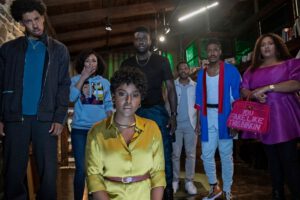Movie Info
Movie Info
- Director
- Tim Story
- Run Time
- 1 hour and 37 minutes
- Rating
- R
VP Content Ratings
- Violence
- 3/10
- Language
- 5/10
- Sex & Nudity
- 1/10
- Star Rating
Relevant Quotes
Whoever sows injustice will reap calamity, and the rod of anger will fail.
The villainies of villains are evil; they devise wicked devices to ruin the poor with lying words, even when the plea of the needy is right.

Fans of horror films know that in most such films it is the rare Black character who dies, if not first, then early on. But what if all the stranded group members are Black—hence the humorous poster stating (in letters larger than those of the title) “WE CAN’T ALL DIE FIRST.” (We might reply to this, “You could if this were a short film—actually it is based on a short film.) Director Tim Story, whose Barbershop is a favorite of mine, has a lot of fun sending up some of the tropes and clichés of the horror genre. Some critics rank the film right up there with Get Out, Jordan Peele’s comedy that in 2017 injected serious themes of racism and white paternalism into the horror genre.
The parody begins with the bringing a group of old classmates getting together—to celebrate Juneteenth and their 10-year college reunion. Then there’s the usual isolated “cabin in the woods,” this time a rather fancy house, but with a creepy basement. There is the usual game that their tormentor demands they play. Here it is a racist board game with a large Sambo face on the box cover. Its name gives the film its title. One of them dubs it “Jim Crow Monopoly.” They see their captor through a TV monitor that is linked to the game. He wears a black-faced leather mask (horror fans will catch the film references), and is armed with a crossbow. The previous day he had killed their friend Shawn and is holding Morgan (Yvonne Orji) as a hostage—play the game or he dies.
The gathering consists of the usual mixture of nerd, a stoner, jock, gay man, and girlfriends. During the encounters with the captor, obviously a white man with a grudge, they react in various ways, often funny. The captor makes them an offer—that if they select the member who is Blackest, he will let them all go. I got some of the humor from the various remarks the gang makes as they discuss who is Blackest, but the screening audience I saw it with, being mostly African Americans, got far more, judging by the volume and frequency of their laughter. This was the case throughout the film—it really is aimed at a Black audience, with us whites welcome to come along and try to catch the jokes. I at least was able to laugh when one of the group admitted to have voted for Trump—laughter, and even more when he added, “twice.” And then, too, the disclaimer by another character, “I CAN’T be the “blackest.” “I thought Black Twitter was a type of seasoning! I like Jimmy Fallon…withOUT The Roots!” (Admittedly, I don’t get the Jimmy Fallon reference.)
After they bungle the offer, the group is ordered to answer a trivia card about Black culture, and they must come up with the correct answer or one of them dies. There are indeed a few deaths and a lot of blood, but more woundings than killings due to the killer’s choice of antique weapon.
There is also one white character other than the killer, a white park ranger (Diedrich Bader), who seems to represent us “woke” liberals who think we understand African Americans, but really do not. There is a lot in the horror genre and white-dominated culture for scriptwriters Dewayne Perkins and Tracy Oliver to parody. Perkins also plays one of the group members, along with Yvonne Orji, Antoinette Robertson, Sinqua Walls, Melvin Gregg, and Jermaine Fowle.
There are some genuine moments of horror, surrounded by words and reactions that evoke laughter. One of the fissures among Blacks is the disapproval by some of interracial marriage as a sell-out by Blacks males when King, who has married a white woman, is asked, “You still a slave to the white man?” He protests, “Y’all gotta stop calling my wife ‘The White Man,’ alright?”
By the end of the film we all should get the point watching this closed group of Blacks assaulted by an outside force as representative what has been going on in the larger culture for some 400 years, even though there is a twist in the plot concerning the identity of the mastermind behind the plot. What happens to the survivors will bring back memories for those old enough to remember what the fire department did to the demonstrating children of Birmingham during the Civil Rights struggle in the 60s.
The foul language might be offensive to some viewers, but the insights gained—such as the horrible turned into humor by those with the right attitude–make this a film that is as timely as it is worth watching.
This review will be in the July issue of VP along with a set of questions for reflection and/or discussion. If you have found reviews on this site helpful, please consider purchasing a subscription or individual issue in The Store.

